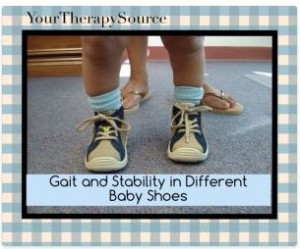Gait and Stability in Different Baby Shoes
[Source: Pediatric Physical Therapy via Your Therapy Source]

Pediatric Physical Therapy published research on the effects of different torsional flexibilities of shoes on gait and stability in 25 children who were walking five months or less. The children were evaluated barefoot and in 4 types of shoes with different torsional flexibilities (UltraFlex, MidFlex, LowFlex, and Stiff). Gait assessments were performed and stability was determined by the number of stumbles/falls during functional tasks.
The results indicated the following:
1. stance time was shorter barefoot compared with all shoe conditions.
2. stance time was shorter in UltraFlex than in LowFlex.
3. step width was wider in UltraFlex than in MidFlex and LowFlex.
4. velocity, step length, and the number of stumbles/falls did not differ significantly across shoe conditions.
5. children walking for 2 months or less had significantly more stumbles and falls than children walking more than 2 months.
The researchers concluded that stance time and step width differ across shoe conditions. Stability was not affected by shoe conditions.
Reference: Buckland, Melanie A. PT, DPT, ATP, C/NDT; Slevin, Corinne M. PT, DPT, MS; Hafer, Jocelyn F. MA; Choate, Cherri DPM; Kraszewski, Andrew P. MS. The Effect of Torsional Shoe Flexibility on Gait and Stability in Children Learning to Walk. Pediatric Physical Therapy – Winter 2014 Vol. 26 – Issue 4: p 411-417
Please Support our Contributors and Visit Your Therapy Source’s blog and website
PediaStaff is Hiring!
All JobsPediaStaff hires pediatric and school-based professionals nationwide for contract assignments of 2 to 12 months. We also help clinics, hospitals, schools, and home health agencies to find and hire these professionals directly. We work with Speech-Language Pathologists, Occupational and Physical Therapists, School Psychologists, and others in pediatric therapy and education.
